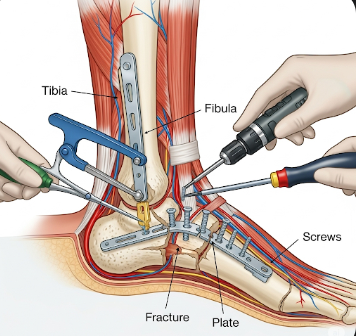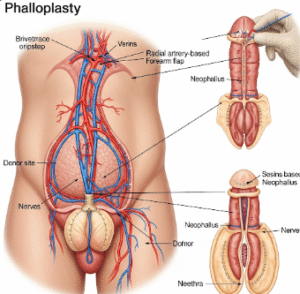Overview
Ankle fracture surgery is a medical procedure performed to repair broken bones in the ankle joint. Fractures can occur due to trauma, sports injuries, falls, or accidents. Surgery is typically recommended for unstable fractures, displaced bones, or multiple bone involvement, ensuring proper alignment and restoring ankle function.
In Korea, ankle fracture surgeries are performed in advanced orthopedic hospitals by highly experienced orthopedic surgeons. Hospitals use modern imaging, precision surgical instruments, and post-operative rehabilitation programs to ensure optimal bone healing, functional recovery, and minimal complications.
What is Ankle Fracture Surgery?
Ankle fracture surgery involves realigning broken bones and fixing them with screws, plates, or rods to restore the normal structure and stability of the ankle joint.
Key points:
- Performed for unstable or displaced fractures
- Ensures proper bone alignment, joint stability, and pain relief
- Uses internal fixation (metal plates and screws) or external fixation depending on fracture type
- May include soft tissue repair if ligaments or tendons are injured
- Goal: prevent long-term complications like arthritis, deformity, or chronic instability
What are the benefits?
- Stabilizes the ankle joint for proper healing
- Restores normal alignment and mobility
- Reduces the risk of long-term complications such as arthritis or chronic pain
- ✅ Allows early mobilization with guided rehabilitation
- ✅ Improves walking, balance, and daily activity performance
- ✅ In Korea, surgeons use advanced surgical techniques and precision tools to optimize recovery
Procedure Details
1) How should I prepare for Ankle Fracture Surgery?
- ➤ Preoperative evaluation: X-rays, CT scans, blood tests, and physical examination
- ➤ Discuss current medications, especially blood thinners or anti-inflammatory drugs
- ➤ Fasting instructions if general anesthesia is planned
- ➤ Preoperative counseling about procedure, risks, recovery, and rehabilitation
- ➤ Arrange for transportation and post-operative care, as mobility will be limited initially
2) What happens during the procedure Ankle Fracture Surgery?
- ✅ Performed under general or regional anesthesia
- ✅ Incision made to access the fracture site
- ✅ Bone fragments are realigned to restore the normal joint structure
- ✅ Internal fixation is applied using screws, plates, or rods
- ✅ In some cases, external fixation may be used temporarily
- ✅ Soft tissues such as ligaments or tendons may be repaired simultaneously
- ✅ Duration varies, typically 1–3 hours, depending on fracture complexity
3) What happens after Ankle Fracture Surgery?
- ➤ Patient monitored in recovery room or hospital ward
- ➤ Pain management using medications as needed
- ➤ Immobilization with cast, splint, or boot
- ➤ Non-weight-bearing on the affected leg for 4–8 weeks, depending on fracture type
- ➤ Gradual physical therapy to regain strength, flexibility, and balance
- ➤ Full return to activities typically within 3–6 months, depending on healing
Risks / Benefits
Potential Risks:
- ➤ Infection at the surgical site
- ➤ Non-union or delayed bone healing
- ➤ Nerve or blood vessel injury
- ➤ Stiffness or limited ankle movement
- ➤ Blood clots or anesthesia-related complications
Benefits:
- ✅ Proper bone alignment and joint stabilization
- ✅ Reduces risk of arthritis and long-term deformities
- ✅ Improves mobility, balance, and daily function
- ✅ Allows early guided rehabilitation
- ✅ In Korea, advanced techniques minimize complications and improve healing outcomes
Recovery and Outlook
- Hospital stay: Usually 1–3 days, depending on fracture severity and surgery type
- Activity: Non-weight-bearing initially; gradual progression with physiotherapy
- Rehabilitation: Focused on strength, range of motion, and gait training
- Full recovery: Usually 3–6 months, depending on fracture complexity and patient health
- Lifestyle: Avoid high-impact activities early, follow rehabilitation guidance, and maintain healthy weight to protect the ankle
When To Call the Doctor
- ➤ Signs of infection: redness, swelling, warmth, or discharge
- ➤ Severe pain not relieved by medication
- ➤ Numbness, tingling, or weakness in the foot or ankle
- ➤ Difficulty bearing weight or sudden instability
- ➤ Fever or unusual symptoms post-surgery
Best Korea Option / Process
- ✅ Korea provides specialized orthopedic centers for ankle fractures
- ✅ Hospitals use modern surgical equipment, experienced surgeons, and precise fixation techniques
- ✅ Post-operative care includes immobilization, pain management, and guided rehabilitation
- ✅ International patients benefit from VIP services, English-speaking staff, and coordinated care
- ✅ High success rates and advanced techniques make Korea a preferred destination for ankle fracture surgery













